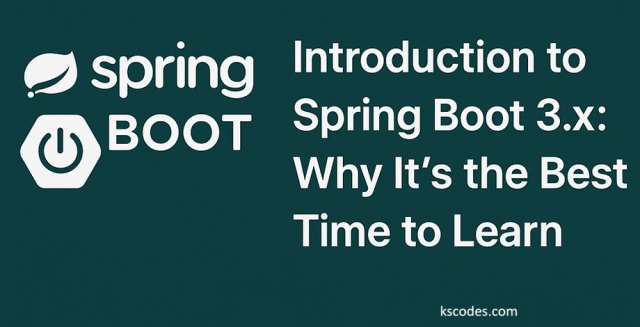Spring Boot is a framework that helps developers build stand-alone, production-ready Java applications quickly and easily. It is built on top of the Spring Framework and removes the need for complex configuration and setup.
🔧 Without Spring Boot
You had to:
- Manually configure dependencies
- Set up XML-based configurations
- Handle servlet containers yourself
✅ With Spring Boot
You get:
- Auto-configurations
- Embedded Tomcat/Jetty server
- Easy integration with databases, messaging systems, and cloud services
It’s like having a pre-configured toolbox that helps you build robust applications faster and smarter.

📦 What’s New in Spring Boot 3.x?
Spring Boot 3.x was released with major upgrades and sets the stage for modern development.
🌐 1. Jakarta EE 10 Support
Spring Boot 3.x is completely based on Jakarta EE 10, not Java EE. This means:
- All packages have moved from
javax.*tojakarta.* - You need to update your imports if migrating
- Full compatibility with latest enterprise Java standards
🧪 2. JDK 17+ Required (Recommended: JDK 21)
Spring Boot 3.x requires Java 17 or higher, and supports Java 21. That’s a good thing because:
- You get modern Java features (records, pattern matching, virtual threads)
- Better performance and security
- Long-term support (LTS)
🧠 3. Improved Observability
Out-of-the-box support for:
- Micrometer
- Prometheus
- OpenTelemetry
- Grafana dashboards
Great for monitoring and debugging production apps.
🏃 4. Native Compilation Support with GraalVM
Spring Boot 3 supports GraalVM Native Images:
- Start-up time is reduced from seconds to milliseconds
- Lower memory usage
- Ideal for cloud and serverless applications
🌩️ 5. Spring Cloud 2022+ Compatibility
Build modern microservices with full Spring Cloud support (Config Server, Eureka, Gateway, etc.)
💡 Why Is Now the Best Time to Learn Spring Boot?
1. 🔄 Major Upgrade, Fresh Start
Spring Boot 3 is not just an upgrade — it’s a new generation.
If you’re new, you don’t have to worry about “legacy” ways — just learn the best practices straight away.
2. 🌎 Real-World Demand
Spring Boot powers:
- Banks & fintech apps
- Healthcare platforms
- E-commerce websites
- Enterprise backends
Over 60% of Java jobs require Spring Boot skills.
3. 📚 Huge Ecosystem & Learning Material
- Thousands of tutorials (like this one!)
- Huge open-source projects to learn from
- Backed by the Spring Team (VMware)
4. ☁️ Cloud & Microservices Friendly
Spring Boot + Spring Cloud is the gold standard for building distributed systems.
5. 🧱 Developer Productivity
- LiveReload with Spring DevTools
- Spring Boot CLI for fast prototyping
- Autoconfiguration reduces 70% of boilerplate code
🔄 From Spring Boot 2.x to 3.x – A Quick Summary
| Feature | Spring Boot 2.x | Spring Boot 3.x |
|---|---|---|
| Java Version | Java 8+ | Java 17+ |
| EE Spec | Java EE / Jakarta EE 8 | Jakarta EE 10 |
| Native Support | Experimental | Production-ready |
| Observability | Manual setup | Built-in metrics/export |
| Performance | Good | Great (esp. with GraalVM) |
✅ Who Should Learn Spring Boot 3.x?
- ✅ Beginners learning Java web development
- ✅ Backend developers moving into microservices
- ✅ Enterprise developers modernizing older Spring apps
- ✅ Freelancers or job seekers aiming for Java-based roles
🧭 Getting Started: What You Need
- Install Java 17 or Java 21
- Use Spring Initializr to generate a starter project
- IDE like IntelliJ IDEA or VS Code
- Use Maven or Gradle for build management
📌 Conclusion
Spring Boot 3.x is the future of Java development. Whether you’re building monoliths or microservices, REST APIs or reactive apps — Spring Boot 3 has the tools, performance, and community to support you.
Start learning it today and you’ll stay ahead in the Java world for the next 5–10 years.